Comparative Analysis and Optimization of Technical and Weight Parameters of Turbo-Electric Propulsion Systems
Abstract
:1. Introduction
2. System Architecture
2.1. Re-Equipped Reference Aircraft
2.2. Architecture
2.3. Requirements
3. Modeling
3.1. Electric Machines
3.2. Gearbox
3.3. Power Electronics
3.4. DC Cables
3.5. Heat Exchanger
3.6. System Optimization
- ①
- For the system, i.e., for each component the following variables are fixed: DC-link voltage V and ambient temperature T.
- ②
- For each component the boundary conditions (e.g., maximum allowable diameter) and the limits on inner degrees of freedom are fixed (e.g., the D/L-ratio of the motor can be varied between 0.3 and 3). Furthermore, the sample size for each degree of freedom is fixed. After fixing the sample sized we had roughly to variants for the gearbox, to variants for each electric machine, 100 variants for each inverter and 2 variants for the cable. All variants are stored as the initial gene-pool of each component where every inner degree of freedom represents one gene. The gene-pool for each component is the set of allowable parameter values that can be used by the optimizer.
- ③
- As the sample size is quite large and many parameter combinations do not yield meaningful designs, the gene-pool for each component is further refined by finding feasible solutions for each component. At first, Latin hypercube sampling is used to cover a uniform subspace of options for each component. Then, for each component the optimization algorithm is performed in the same way as for the system. The results of this optimization serve as the final gene-pool for each component during the system optimization.
- ④
- The initial system population is created by choosing N = 2400 random configurations from the gene-pool for each component.
- ⑤
- For each configuration of the system, mass and efficiency are calculated according the design process demonstrated in Figure 3.
- ⑥
- For all calculated configurations, pareto-fronts are calculated and each configuration is assigned a rank according to the pareto-front that it belongs to.
- ⑦
- Parent configurations for the breeding of the next-generation offsprings are selected according to their rank. The parents belonging to one rank were not sorted (according to mass or efficiency) but the parents are chosen randomly for cross-over. N = 800 parent configurations were selected for cross-over.
- ⑧
- N = 600 offspring configurations were created by cross-over from the parent configurations according to the following rule: Gearbox configuration and gear ratio was inherited from parent configuration 1; geometry parameters of electric machines (motor and generator) were inherited from parent configuration 1, while number of pole pairs, number of slots and stator current density J were inherited from parent configuration 2; inverter topology was inherited from parent configuration 1, while the coolant inlet temperature T was inherited from parent 2; cable material was inherited from parent configuration 1.
- ⑨
- N = 60 mutations are performed on the offspring configurations that are chosen randomly. For each component one gene is chosen randomly to be mutated and then the new value of the gene is selected randomly from the gene-pool of the component that was generated in step 3.
- ⑩
- Steps 5 to 8 are repeated N = 10 times. The calculations are always performed only for the offsprings but not for the parents that remained in the population, while the selection of parents (step 5) is performed for all configurations (i.e., parents and offspring).
- The maximum allowable diameter for the propulsion motor d < 0.6 m.
- The maximum allowable length for the propulsion motor l < 0.9 m.
- The maximum allowable rotation speed at the shaft of the propulsion motor n < 21,000 min.
- The maximum allowable diameter for the generator d < 0.5 m.
- The maximum allowable length for the generator l < 2 m.
- The maximum allowable electric frequency for electric machines and inverters f < 4 kHz.
- The maximum allowable temperature for the conductors in the stator of the electric machines T < 180 °C.
- The maximum allowable temperature for the inverter power modules T < 170 °C.
- The maximum allowable temperature in the center of the cable conductor T < 180 °C.
4. Results
4.1. Optimization
4.2. Electric Machines and Gearbox
4.3. Power Electronics
4.4. DC Power Cables
4.5. Complete Electric Propulsion System
4.6. Single Component Optimization Versus System Optimization
5. Discussion of Results
- The lowest weight for a turbo-electric propulsion system without cryogenic components could be around 9.9 t to 12.9 t with efficiencies in the range between 92% to 94%. This weight includes the gearbox, electric machines, inverters, cables and heat exchangers. Not included are the propulsors, the gas turbines, protection devices and the battery.
- Optimal DC-link voltages are in the range of V = 2 kV. This result is mainly driven by a trade-off between the cable masses and the usable modules for the inverters.
- Optimal electric frequencies are in the range 1.5 kHz ≤ f ≤ 3.0 kHz. Optimal power factors for electric machines are around 0.7 to 0.8.
- Designs with gearbox tend to be the lighter than direct drive solutions with n = 3500 min. Optimal gear ratios appear to be from 3 to 5, i.e., motor rotation speeds from n = 10,500 min to n = 17,500 min are favorable.
- The choice of optimal inverter topology depends strongly on the DC-link voltage. For V = 2 kV and V = 4 kV, the optimal choice is 3LNPC, while for V = 1 kV and V = 3 kV, a 2L-topology is the better choice. 5LSMC can be advantageous for V = 3 kV to achieve higher efficiencies.
- The heat exchanger can contribute a large proportion of the system weight (up to 40%) and have an impact on the optimal choice of inverter modules and motor rotation speed.
- Optimal designs for single components do not yield necessary the best designs for an optimal system.
- The weight advantage of a cryogenic electric propulsion system to a non-cryogenic electric propulsion system is roughly 1.5 t to 3.5 t depending on the assumption for the heat-exchanger. In terms of power density this would be an increase from 3.1 kW/kg to 4.8 kW/kg. The efficiency of the cryogenic system can be better by 6% to 8%. In a configuration with batteries, this would give the cryogenic system an additional weight advantage over the non-cryogenic system.
- Comparing the power-to-weight ratio of both the CEPS and TEPS designs to the power-to-weight ratio of the state-of-the-art turbofan drive train (which is about 8 kW/kg), it is obvious that both solutions perform worse concerning power density. This is not surprising, since the turbo-electric drive train configuration acts as an electric transmission between the gas turbine and the fan, simply adding more components to the drivetrain and reducing its efficiency. Thus, advantages can only be leveraged if batteries are added as a highly efficient boost power source for take-off (and taxi) and/or the aircraft architecture is redesigned to make use of the new degrees of freedom that a hybrid-electric configuration offers [4,38].
- A large part of the weight advantage of the cryogenic system does not come solely from lighter cables and electric machines but from the cooling systems. Indeed the heat-exchanger including its peripheral systems could significantly outweigh the mass of liquid hydrogen (and the required tanks). For shorter missions even less hydrogen would be required, thus giving an additional weight advantage. Furthermore, liquid hydrogen that would be added to the turbine, could further increase its efficiency by up to 6%. In contrast, a heat-exchanger would produce additional drag of 3% to 5% [39,40]. In principle, a part of the waste heat can be used for fuel pre-heating to avoid these drag losses due to the heat-exchanger. However, the Jet-A1 does not provide sufficient heat-capacity to absorb all the waste heat from the electric components, wherefore the heat-exchanger remains necessary in the non-cryogenic case. Summing up these effects and taking into account the efficiency of the electric system, the cryogenic propulsion system could have an total efficiency advantage of up to 12% to 18%.
- The optimal DC-link voltages are similar for both non-cryogenic and cryogenic designs. They are around V = 2 kV.
- For the lightest non-cryogenic designs, a gearbox with a gear ratio from 3 to 5 and high electric frequencies up to f 3 kHz is required. In the cryogenic case with superconducting components direct drives with electric frequencies f 350 Hz yield the best solutions. Here, the strong influence of the AC losses in superconductors limits the frequency to such small values.
6. Conclusions
- Since the heat-exchanger has a significant influence on the total system weight, it is important to include a sizing model for the heat-exchanger. This will lead to interesting trade-offs concerning the inlet/outlet temperature of heat-exchanger and the electric machines and power electronics. Furthermore, the drag losses of the heat-exchanger could be included into the total system efficiency.
- An important component that was left out so-far during the sizing but is inevitable are protection devices. Analytical sizing models for current-fault limiters and switches must be derived and included into the system sizing.
- The sizing of the corresponding battery for the Taxi, Take-Off and Climb segments of the mission.
- A more detailed modeling of the electric machines and inverters for the most interesting designs (e.g., by FE-solvers for electric machines and software-tools like PLECS for power electronics).
- One important issue that was not looked into was the reliability and fault tolerance of the components, since the component design requires items that have not been built and tested yet. Hence, no reliability and fault tolerance modeling could be done at this point. Once reliability data is available for items that are similar enough to what is required for the designs, a reliability analysis should be included in the design flow.
- Modeling of the transient system behavior with 1D-transient system analysis tools like SimCenter Amesim or Matlab Simulink.
- A long-term goal should be a combined sizing loop of aircraft and drivetrain system that should also include a propulsor and turbine sizing model.
Author Contributions
Funding
Acknowledgments
Conflicts of Interest
Abbreviations
| Abbreviation | Explanation |
| 2L | Two-Level inverter topology |
| 3LFC | Three-level flying capacitor inverter topology |
| 3LNPC | Three-level neutral point clamp inverter topology |
| 3LTNPC | Three-level T-type neutral point clamp inverter topology |
| 5LSMC | Five-level stacked multicell inverter topology |
| AC | Alternating current |
| CEPS | Cryogenic turbo-electric propulsion system |
| Carbon dioxide | |
| CS-25 | European certification specifications document for large aircraft |
| DC | Direct current |
| iDoF | Internal degrees of freedom |
| EPU | Electric propulsion unit |
| FEA | Finite element analysis |
| HEPS | Hybrid-electric propulsion system |
| IGBT | Insulated-gate bipolar transistor |
| MOSFET | Metal–oxide–semiconductor field-effect transistor |
| PAX | Passengers |
| PLECS | Piecewise linear electric current simulation |
| SFC | Specific fuel consumption |
| SiC | Silicon Carbide |
| TEPS | Non-cryogenic turbo-electric propulsion system |
| THD | Total harmonic distortion |
| Symbol | Explanation |
| cos() | Power factor of electric machine |
| d | Maximal allowable diameter for the i-named component [mm] |
| D | Rotor diameter of electric machine [mm] |
| f | Electric frequency of the i-named component [Hz] |
| Weight-to-power ratio of the heat-exchanger [kg/kW] | |
| J | Current density in the stator slot [A/mm] |
| l | Maximal allowable length for the i-named component [mm] |
| L | Rotor length of electric machine [mm] |
| m | Mass of the i-named component [kg] |
| n | Rotation speed at the shaft of electric machines [min] |
| n | Rotation speed at the shaft of the gas turbine [min] |
| N | Number of poles in electric machines |
| N | Number of initial configurations in population |
| N | Number of calculated generations |
| N | Number of breed offspring configurations per generation |
| N | Number of selected parent configurations per generation |
| Efficiency of the i-named component [%] | |
| P | Electric power of the i-named component [MW] |
| T | Temperature of the i-named component [°C] |
| V | DC-link voltage [kV] |
References
- Darecki, M.; Edelstenne, C.; Enders, T.; Fernandez, E.; Hartman, P.; Herteman, J.P.; Kerkloh, M.; King, I.; Ky, P.; Mathieu, M.; et al. Flightpath 2050: Europe’s Vision for Aviation: Report of the High Level Group; ACARE: Derby, UK, 2011. [Google Scholar] [CrossRef]
- International Air Transport Association. IATA Technology Roadmap; IATAN: Miami, FL, USA, 2013. [Google Scholar]
- Felder, J.; Kim, H.; Brown, G. Turboelectric distributed propulsion engine cycle analysis for hybrid-wing-body aircraft. In Proceedings of the 47th AIAA Aerospace Sciences Meeting Including the New Horizons Forum and Aerospace Exposition, Orlando, FL, USA, 5–8 January 2009; p. 1132. [Google Scholar] [CrossRef] [Green Version]
- DelRosario, R. A future with hybrid electric propulsion systems: A NASA perspective. In Proceedings of the Turbine Engine Technology Symposium, Dayton, OH, USA, 11 September 2014. [Google Scholar]
- Schulz, E. Global Networks, Global Citizens. Global Market Forecast 2018–2037; Airbus: Blagnac, France, 2018. [Google Scholar]
- Berg, F.; Palmer, J.; Miller, P.; Dodds, G. HTS system and component targets for a distributed aircraft propulsion system. IEEE Trans. Appl. Supercond. 2017, 27, 1–7. [Google Scholar] [CrossRef]
- Wheeler, P. Technology for the more and all electric aircraft of the future. In Proceedings of the 2016 IEEE International Conference on Automatica (ICA-ACCA), Curico, Chile, 19–21 October 2016; pp. 1–5. [Google Scholar] [CrossRef]
- Martin, B.; Stefan, B.; Corduan, M.; Filipenko, M.; Matthias, N.; Peter, R.; Pham, Q.H. A Holistic System Approach for Short Range Passenger Aircraft with Cryogenic Propulsion System. Supercond. Sci. Technol. 2020, 33. [Google Scholar] [CrossRef]
- AIRBUS S.A.S. A321 Aircraft Characteristics Airport and Maintenance Planning. 2019. Available online: https://www.airbus.com/content/dam/corporate-topics/publications/backgrounders/techdata/aircraft_characteristics/Airbus-Commercial-Aircraft-AC-A321.pdf (accessed on 13 September 2019).
- Pratt & Whitney. Geared Turbofan Commercial Engines; Pratt & Whitney: East Hartford, CT, USA, 2019. [Google Scholar]
- Greatrix, D.R. Turboprop and Turboshaft Engines. In Powered Flight; Springer: Berlin, Germany, 2012; pp. 269–289. [Google Scholar]
- EASA. Certification Specifications for Large Aeroplanes, CS-25, 2009; EASA: Cologne, Germany, 2009.
- Hsieh, M.F.; Hsu, Y.C. A Generalized Magnetic Circuit Modeling Approach for Design of Surface Permanent-Magnet Machines. IEEE Trans. Ind. Electron. 2012, 59, 779–792. [Google Scholar] [CrossRef]
- Krug, D. Vergleichende Untersuchungen von Mehrpunkt-Schaltungstopologien mit zentralem Gleich-Spannungszwischenkreis für Mittelspannungsanwendungen. [Comparison of Medium-Voltage Multilevel Converters with Central DC Link, Chapter 3]. Ph.D. Thesis, TU Dresden, Dresden, Germany, 2016. (In German). [Google Scholar]
- Biser, S.; Wortmann, G.; Ruppert, S.; Filipenko, M.; Noe, M.; Boll, M. Predesign Considerations for the DC Link Voltage Level of the CENTRELINE Fuselage Fan Drive Unit. Aerospace 2019, 12, 126. [Google Scholar] [CrossRef] [Green Version]
- Cao, W.; Mecrow, B.C.; Atkinson, G.J.; Bennett, J.W.; Atkinson, D.J. Overview of Electric Motor Technologies Used for More Electric Aircraft (MEA). IEEE Trans. Ind. Electron. 2012, 59, 3523–3531. [Google Scholar] [CrossRef]
- Golovanov, D.; Papini, L.; Gerada, D.; Xu, Z.; Gerada, C. Multidomain optimization of High-Power-Density PM Electrical Machines for System Architecture Selection. IEEE Trans. Ind. Electron. 2018, 65, 5302–5312. [Google Scholar] [CrossRef]
- Sorong, H.; Jian, L.; Leonardi, F.; Lipo, T. A general approach to sizing and power density equations for comparison of electrical machines. IEEE Trans. Ind. Electron. 1998, 34, 92–97. [Google Scholar] [CrossRef] [Green Version]
- Siemens PLM Software Inc. Simcenter SPEED: PC-BDC 13.06 User’s Manual; SIEMENS: Plano, TX, USA, 2018. [Google Scholar]
- Boresi, A.P.; Schmidt, R.J. Advanced Mechanics of Materials, 6th ed.; Wiley: New York, NY, USA, 2003. [Google Scholar]
- Eslami, M.R. Theory of Elasticity and Thermal Stresses: Explanations, Problems and Solutions; Solid Mechanics and Its Applications; Springer: Dordrecht, The Netherlands, 2013; Volume 197. [Google Scholar]
- Verband der TÜ V e.V. AD2000-Merkblatt B 6: Zylinderschalen unter ä us erem Ü berdruck. Available online: https://www.beuth.de/de/technische-regel/ad-2000-merkblatt-b-6/316608794 (accessed on 27 May 2020).
- IEC 60664-1:2007. Insulation Coordination for Equipment within Low-Voltage Systems; IEC: Geneva, Switzerland, 2007. [Google Scholar]
- Shin Etsu N39UH Nd-Fe-B Magnet Demagnetization Curves at Elevated Temperature. 2016. Available online: http://www.shinetsu-rare-earth-magnet.jp/e/download/N39UHsheet.pdf (accessed on 6 May 2019).
- Von Roll Schweiz, A.G. Winding Wires and Litz Wires. 2019. Available online: https://www.vonroll.com/userfiles/downloads/1576761040530073/2.01.1_Wire_EN.pdf (accessed on 17 January 2020).
- 3M Novec 7500 Engineered Fluid Product Information. 2018. Available online: https://multimedia.3m.com/mws/media/65496O/3mtm-novectm-7500-engineered-fluid.pdf (accessed on 7 May 2019).
- KISSSoft AG. KissSys. 2019. Available online: https://www.kisssoft.ch/english/products/kisssys.php (accessed on 7 May 2019).
- Zakrzewski, A. Gearbox Model for Hybrid-Electric Propulsion Systems. Master’s Thesis, University of Stuttgart, Stuttgart, Germany, 2019. [Google Scholar]
- Akturk, A.; Wilkins, R.; McGarrity, J.; Gersey, B. Single event effects in Si and SiC power MOSFETs due to terrestrial neutrons. IEEE Trans. Nucl. Sci. 2016, 64, 529–535. [Google Scholar] [CrossRef]
- Krug, D.; Bernet, S.; Fazel, S.S.; Jalili, K.; Malinowski, M. Comparison of 2.3-kV Medium-Voltage Multilevel Converters for Industrial Medium-Voltage Drives. IEEE Trans. Ind. Electron. 2007, 54, 2979–2992. [Google Scholar] [CrossRef]
- Ilgevicius, A. Analytical and Numerical Analysis and Simulaiton of Heat Transfer in Electrical Conductors and Fuses. Ph.D. Thesis, Universität der Bundeswehr München, Munich, Germany, 2014. [Google Scholar]
- Chapmann, J.W.; Schulo, S.L.; Nitzsche, M.P. Development of a Thermal Management System for Electrified Aircraft. In Proceedings of the AIAA Scitech 2020 Forum, Orlando, FL, USA, 6–10 January 2020. [Google Scholar] [CrossRef]
- Konak, A.; Coit, D.W.; Smith, A.E. Multi-Objective Optimization Using Genetic Algorithms: A Tutorial. Reliab. Eng. Syst. Saf. 2006, 91, 992–1007. [Google Scholar] [CrossRef]
- Fonseca, C.; Fleming, P. Multiobjective optimization and multiple constrainthandling with evolutionary algorithms. I. A unified formulation. IEEE Trans. Syst. Man Cybern. Part A (Syst. Hum.) 1998, 28, 26–37. [Google Scholar] [CrossRef] [Green Version]
- Srinivas, N.; Deb, K. Multiobjective Optimization Using Nondominated Sorting in Genetic Algorithms. J. Evol. Comput. 1994, 2, 221–248. [Google Scholar] [CrossRef]
- Madonna, V.; Giangrande, P.; Galea, M. Electrical Power Generation in Aircraft: Review, challenges and opportunities. IEEE Trans. Transp. Electrif. 2018, 4, 646–659. [Google Scholar] [CrossRef]
- Coroplast Fritz Müller GmbH & Co. KG. Wires and Cables: Complete Product Range for Automotive Applications. 2020. Available online: https://www.coroplast.de/fileadmin//user_upload/Coroplast_Wires_and_Cables_EN.pdf (accessed on 9 March 2020).
- Pornet, C.; Gologan, C.; Vratny, P.; Seitz, A.; Schmitz, O.; Isikveren, A.; Hornung, M. Methodology for Sizing and Performance Assessment of Hybrid Energy Aircraft. J. Aircr. 2014, 52, 341–352. [Google Scholar] [CrossRef]
- Rodger, D. Key Performance Parameters for Future NATO Hybrid/Electric Military Air Vehicles. In Proceedings of the 31st Congress of the International Council of the Aeronautical Sciences, Belo Horizonte, Brazil, 9–14 September 2018. [Google Scholar]
- Rheaume, J.M.; Macdonald, M.; Lents, C.E. Commercial Hybrid Electric Aircraft Thermal Management System Design, Simulation, and Operation Improvements. In Proceedings of the AIAA Propulsion and Energy Forum 2019, Indianapolis, IN, USA, 19–22 August 2019. [Google Scholar] [CrossRef]
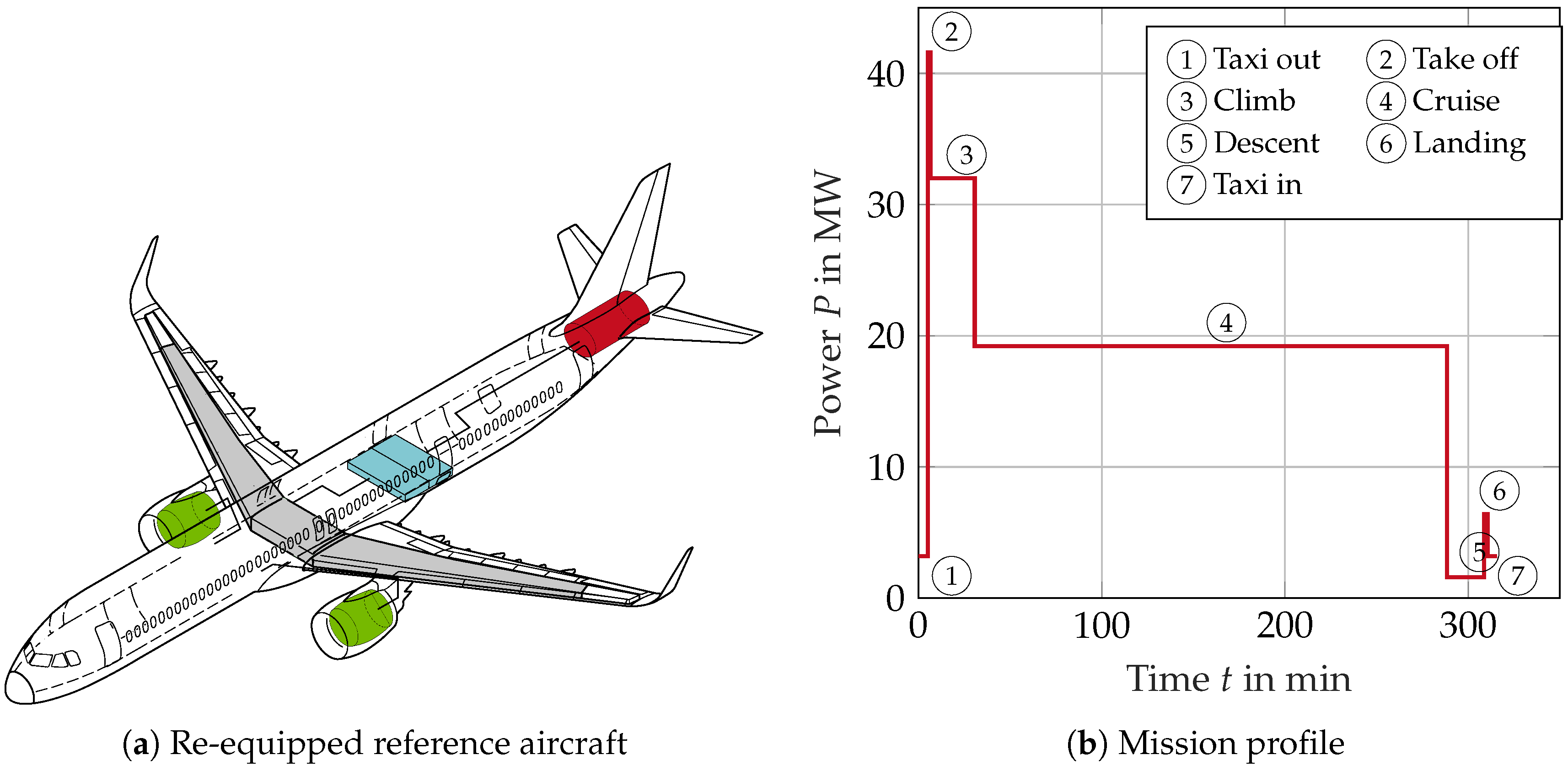
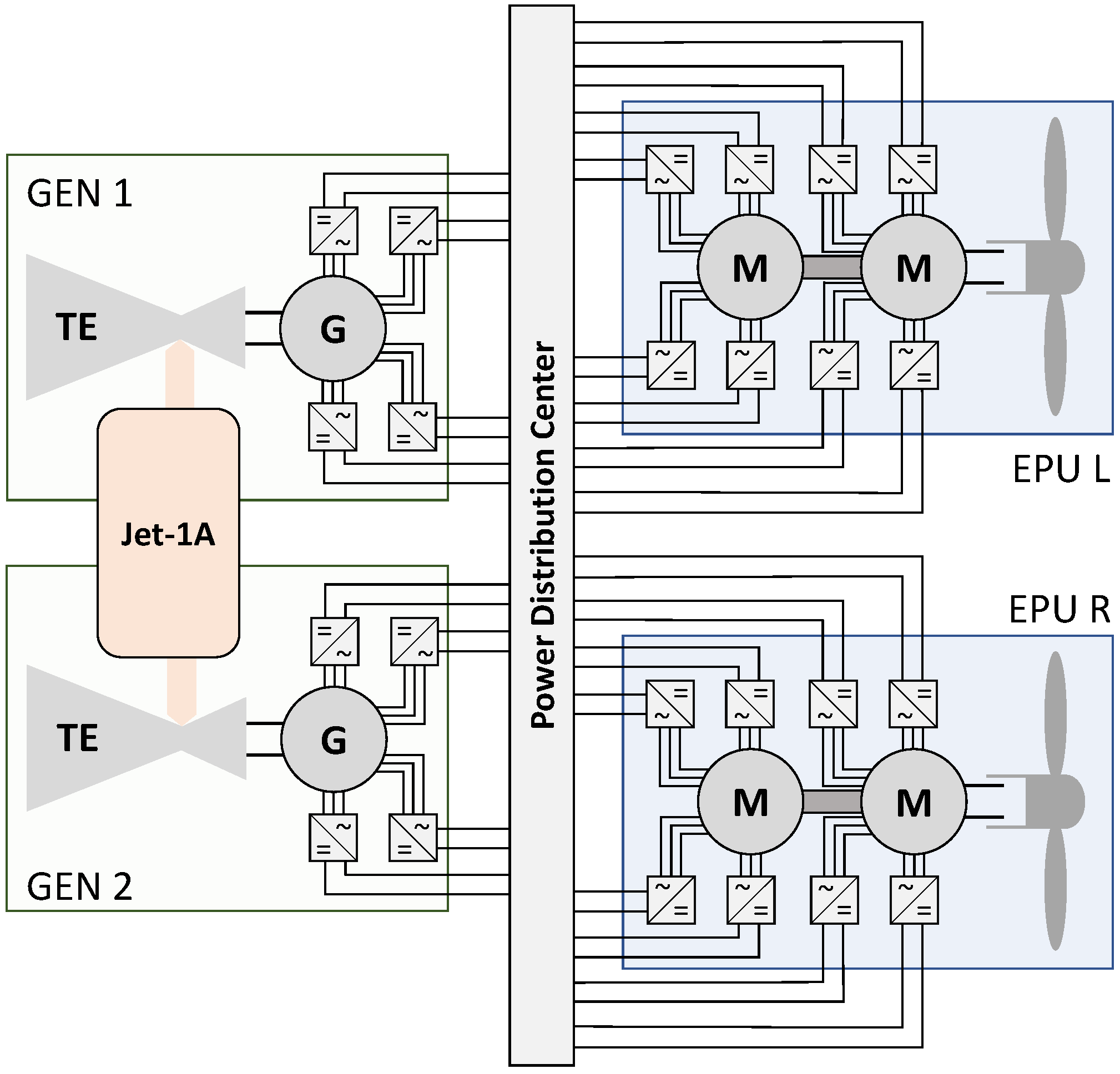
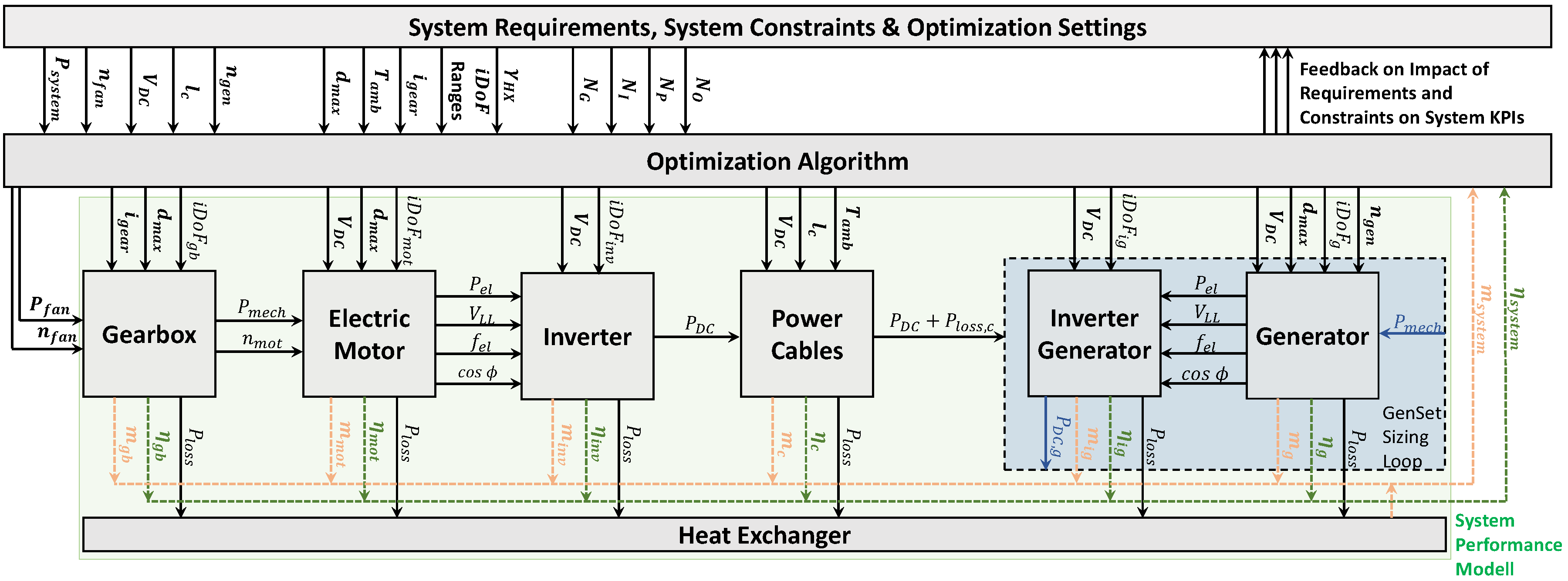
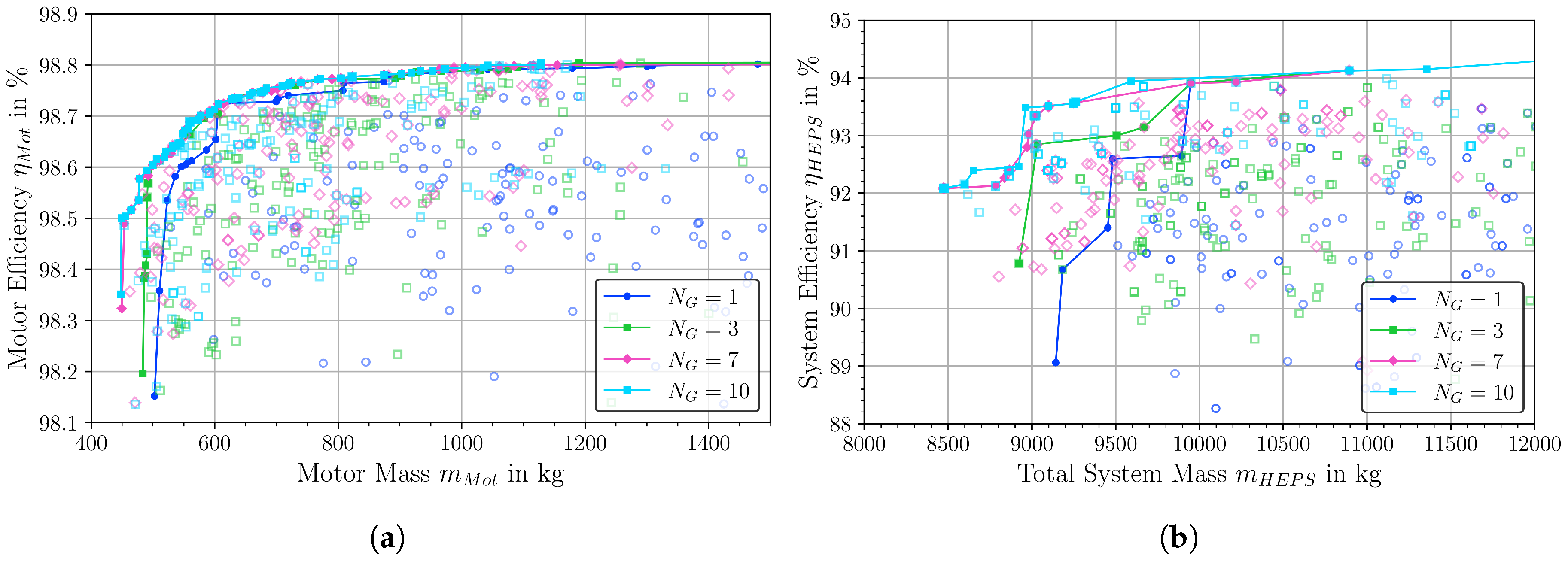
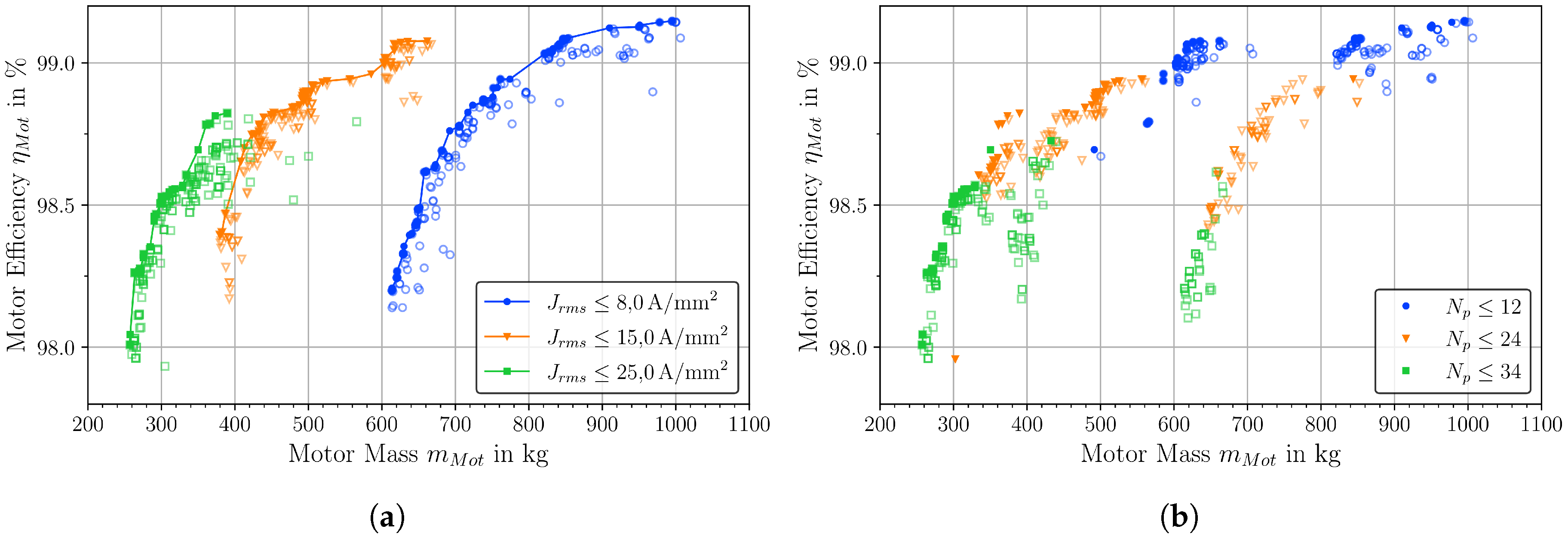

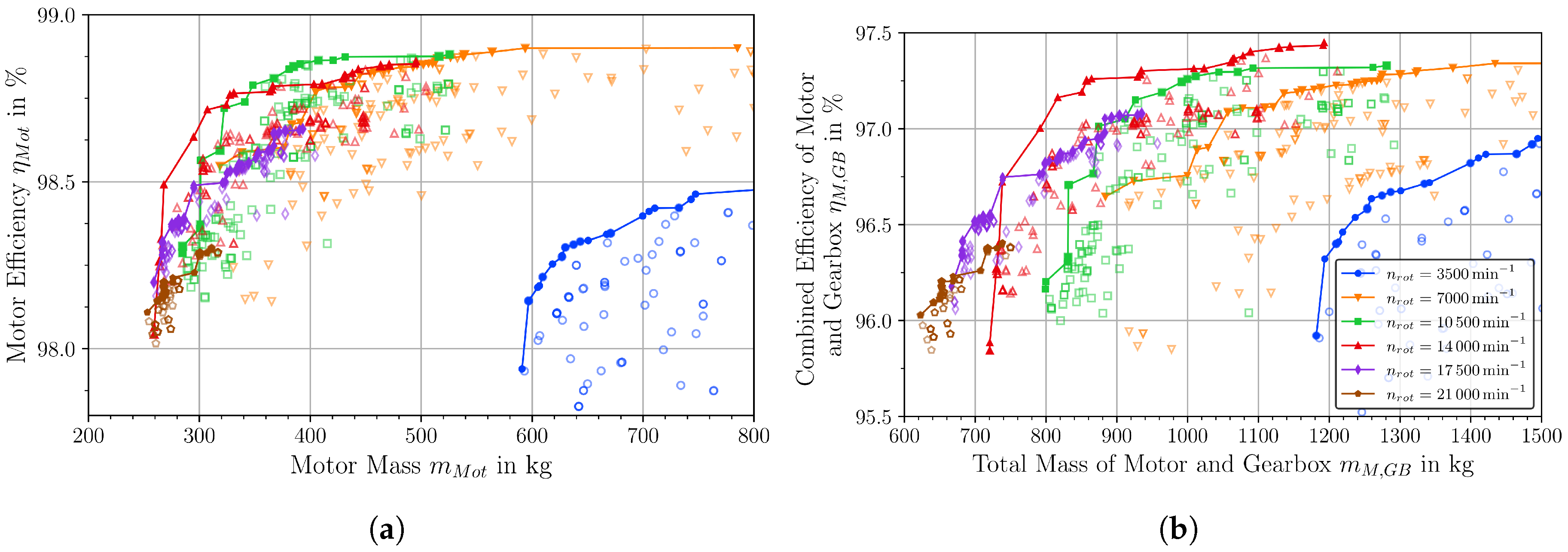
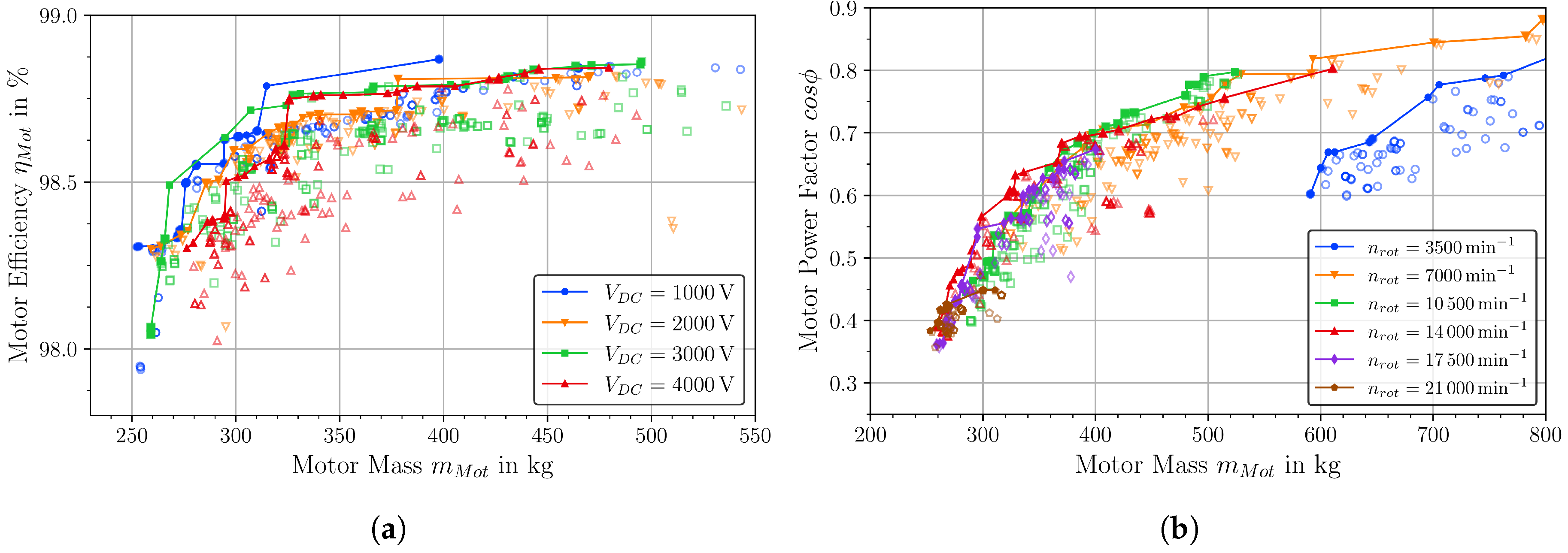
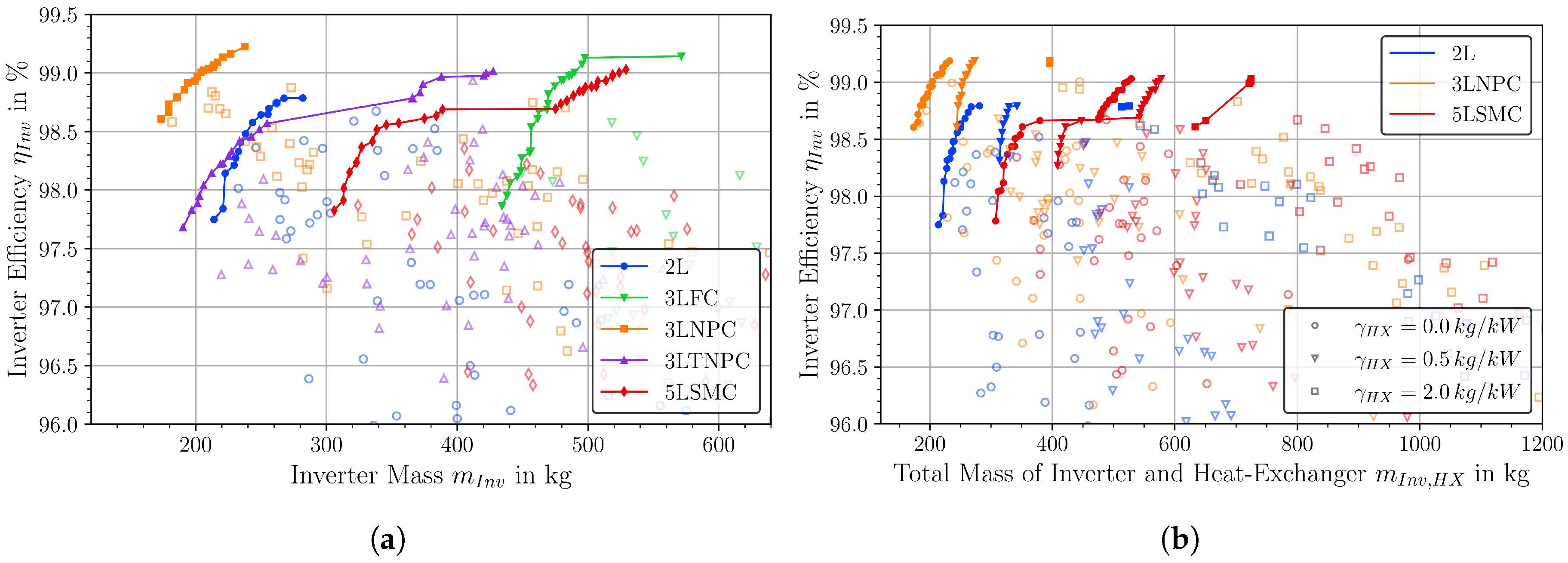
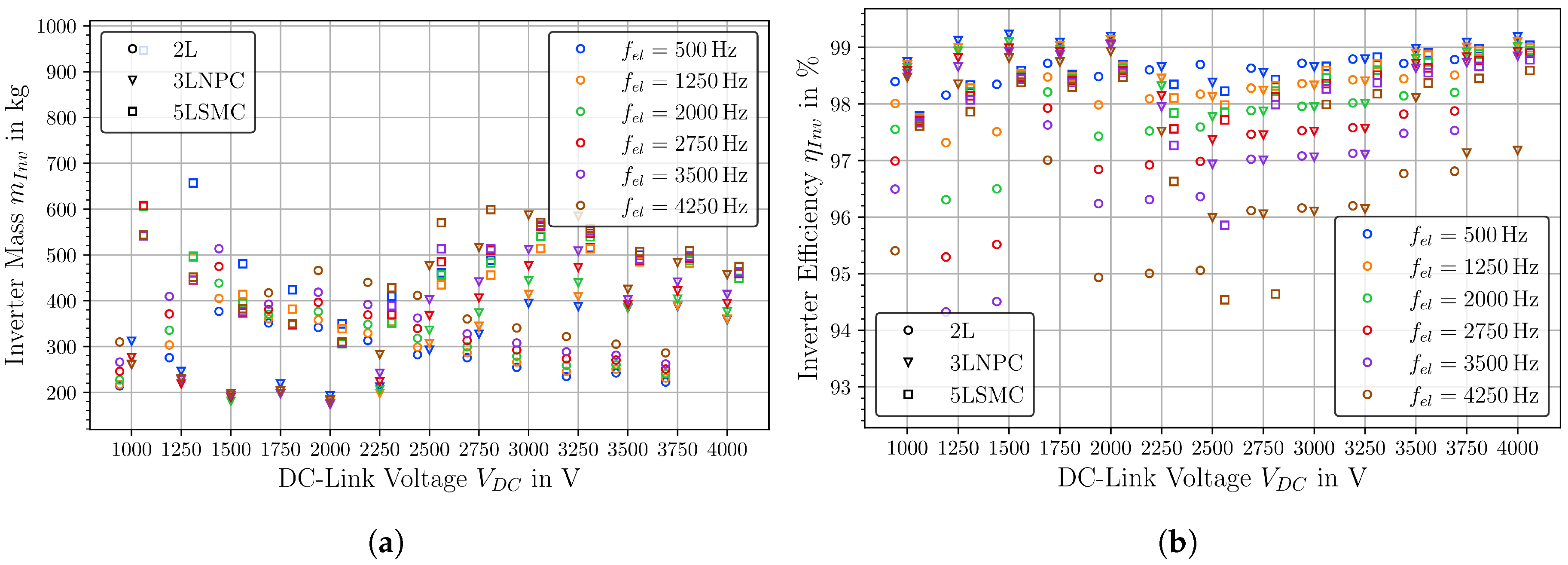
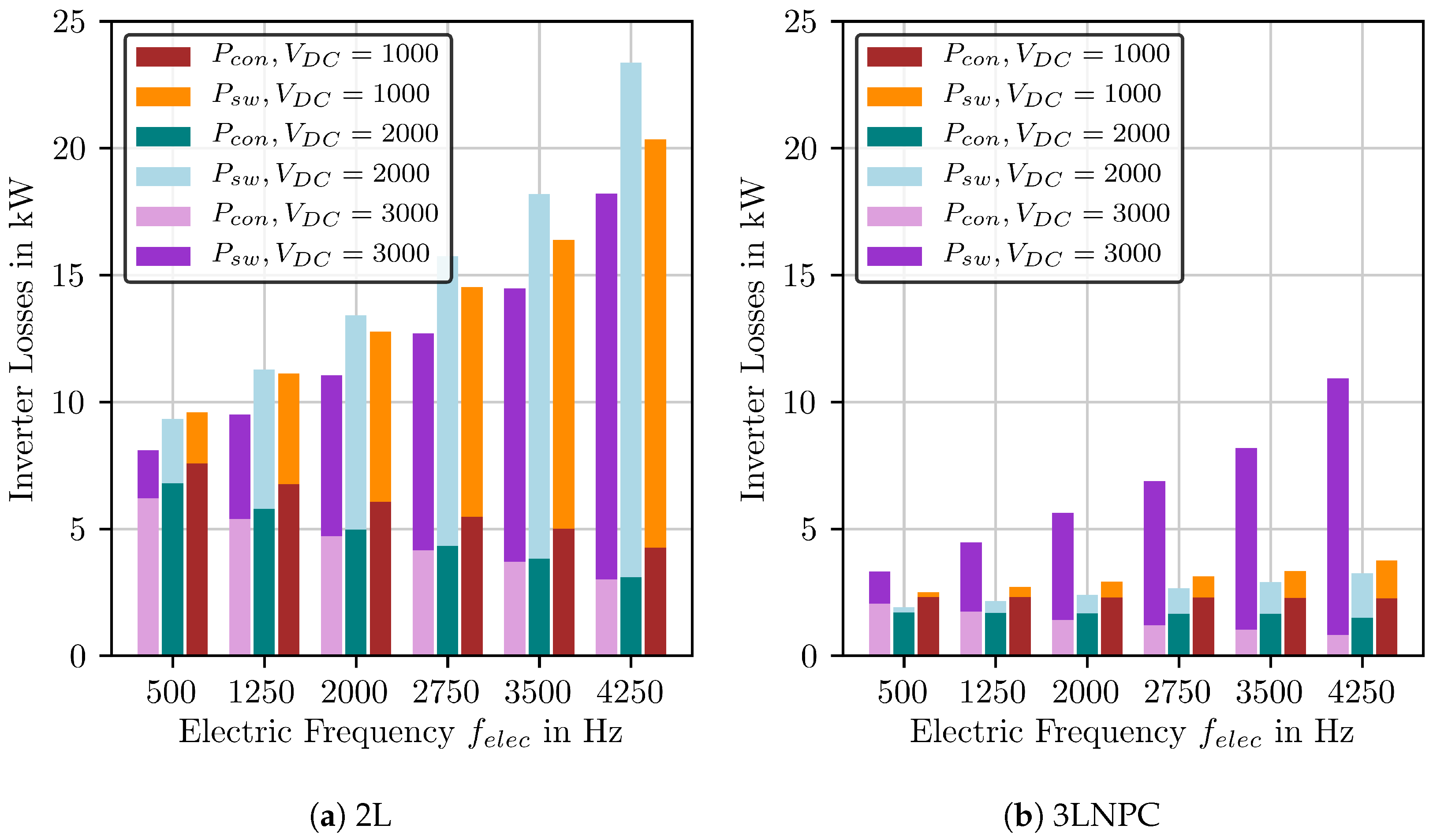

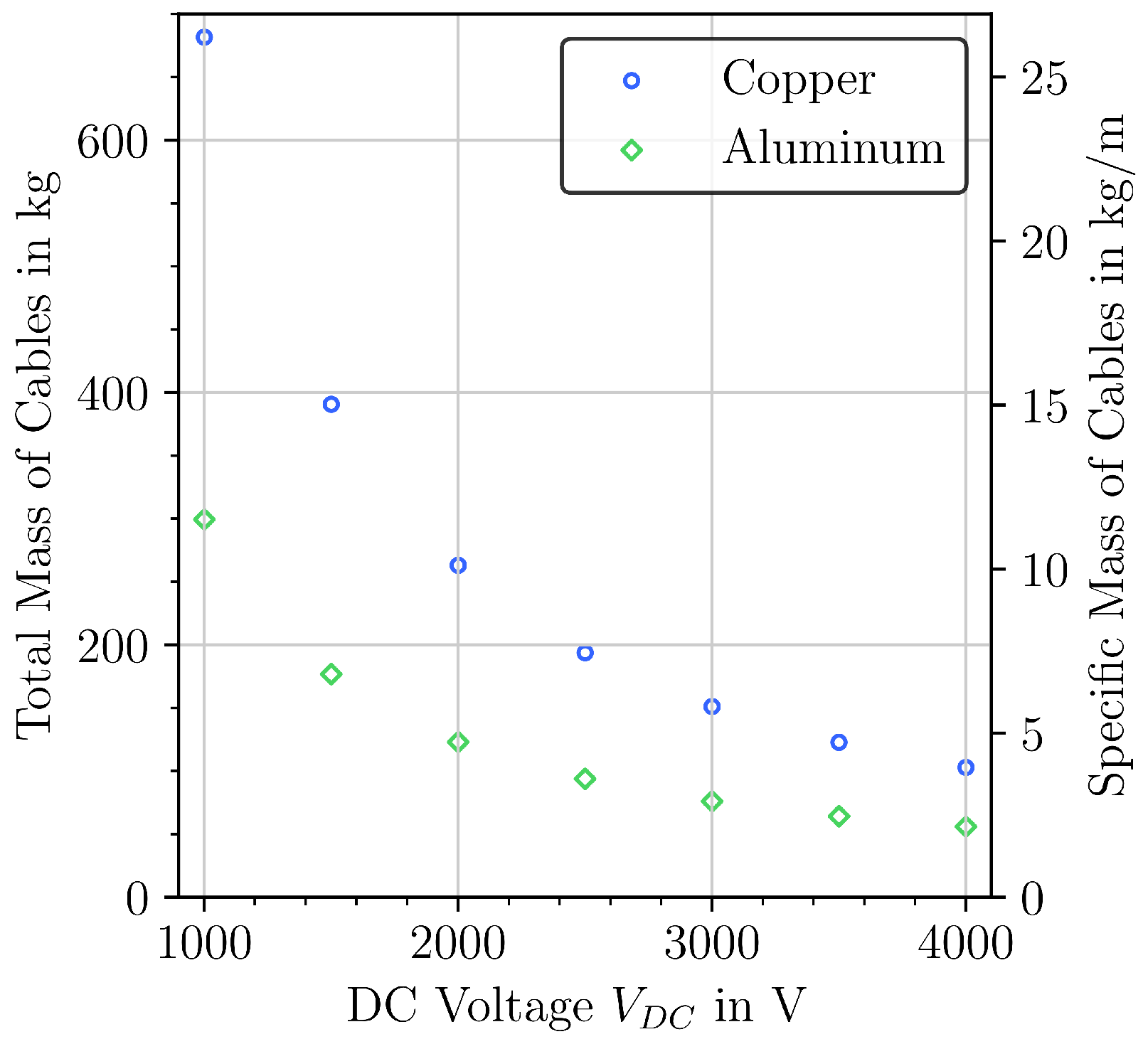
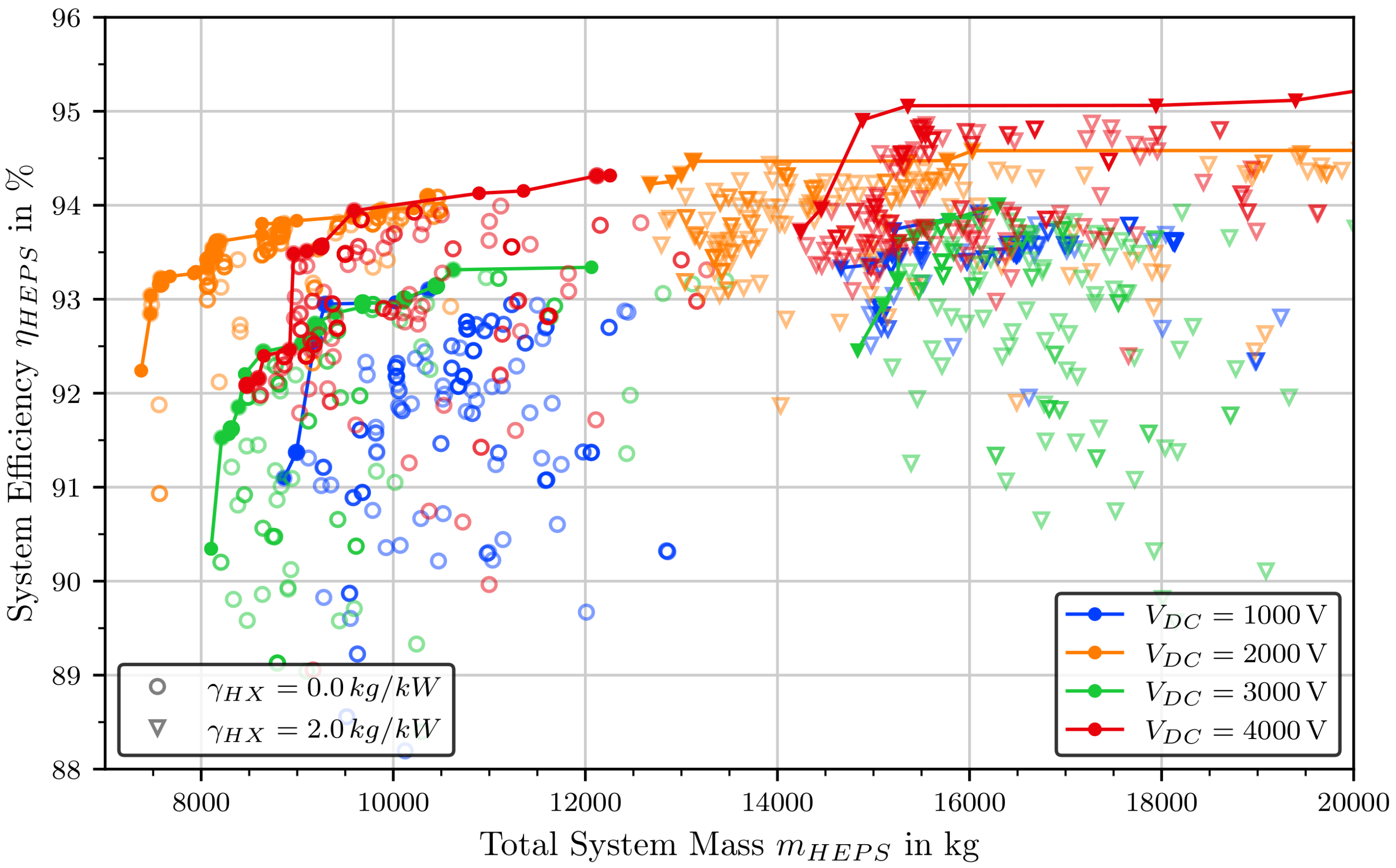


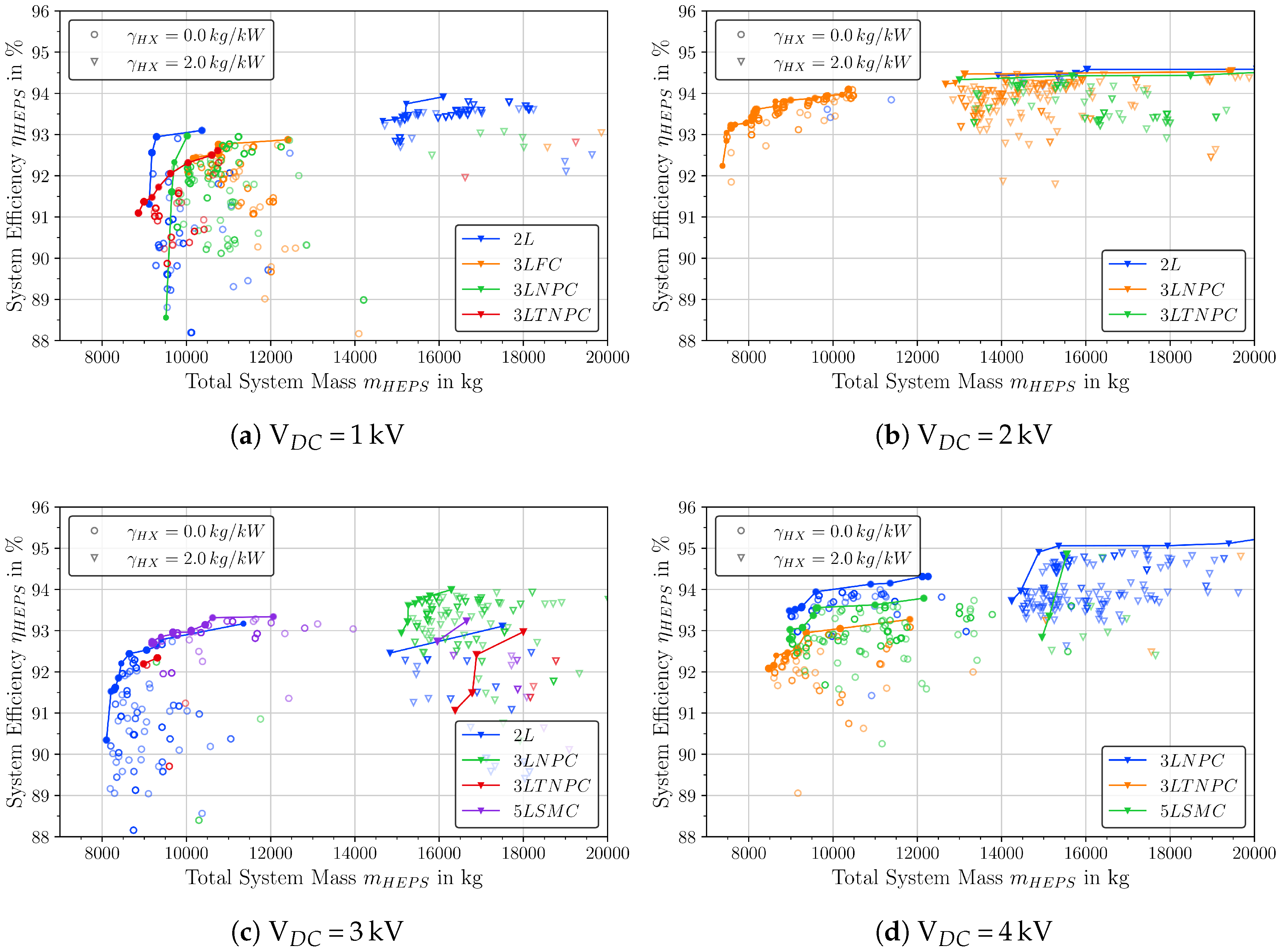
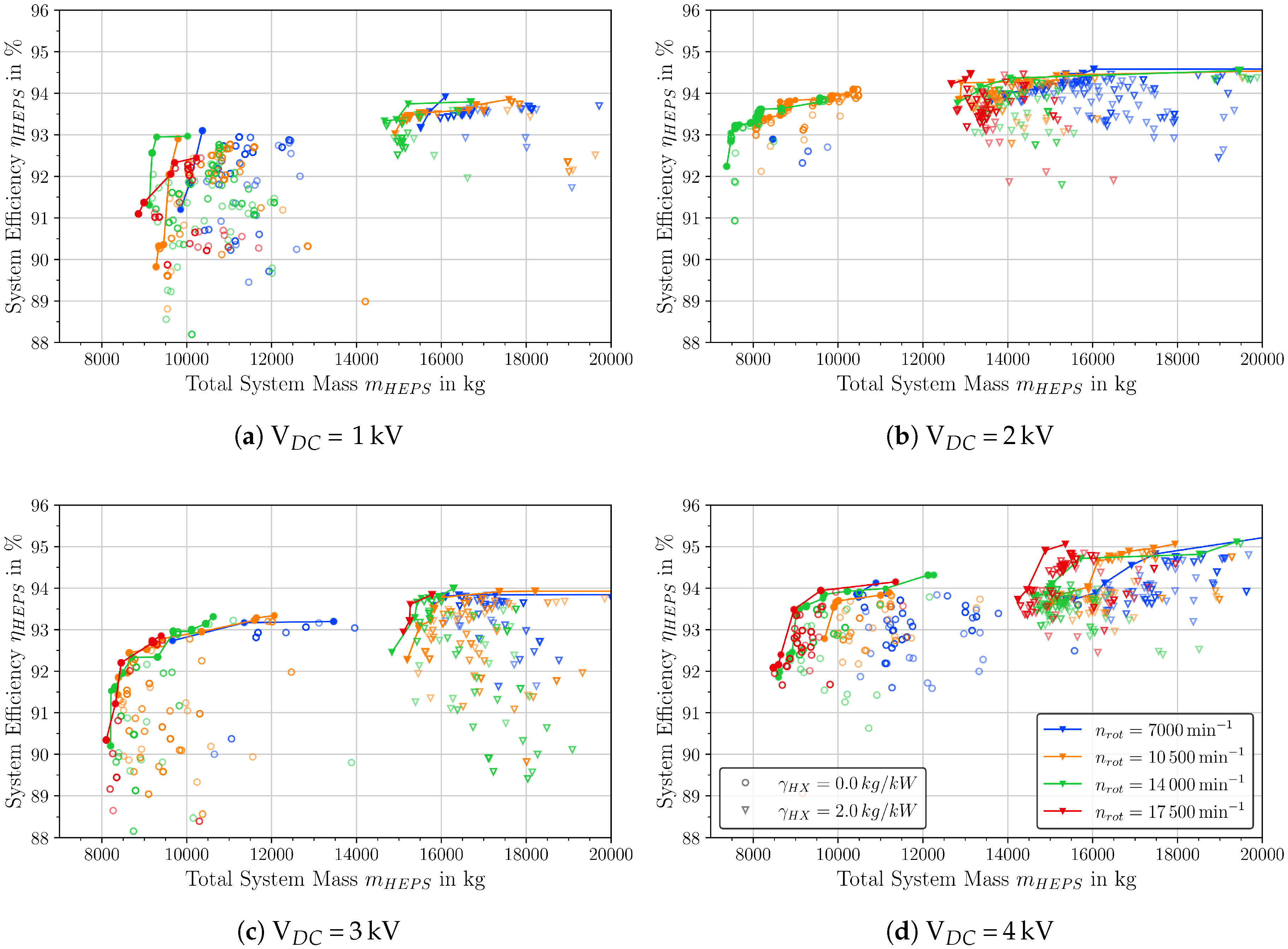


| Type | Symbol | Unit | Range/Value |
|---|---|---|---|
| V | 1000–4000 | ||
| T | 218–318 | ||
| Global | p | 1013 | |
| FL | 40,000 | ||
| l | |||
| f | 175–4000 | ||
| P | |||
| EPU | n | 3500–21,000 | |
| d | |||
| l | |||
| f | 333–4000 | ||
| P | |||
| Gen | n | 10,000 | |
| d | |||
| l |
| Type | Symbol | Unit | Value | Value | Value |
|---|---|---|---|---|---|
| Global | |||||
| V | 2000 | 2000 | 2000 | ||
| m | 7610 | 9904 | 12,998 | ||
| % | |||||
| Gearbox | 446 | 606 | 446 | ||
| % | |||||
| Motor | f | 2333 | 2800 | 1750 | |
| n | 17,500 | 14,000 | 17,500 | ||
| l | |||||
| cos() | |||||
| m | 440 | 357 | 444 | ||
| % | |||||
| Inv | Topology | 3LNPC | 3LNPC | 3LTNPC | |
| 41 | 45 | 56 | |||
| % | |||||
| Cable | 32 | 32 | 32 | ||
| % | |||||
| Rectifier | Topology | 3LNPC | 3LNPC | 3LNPC | |
| 109 | 113 | ||||
| % | |||||
| Gen | f | 2167 | 1167 | 1000 | |
| n | 10,000 | 10,000 | 10,000 | ||
| l | |||||
| cos() | |||||
| m | 1202 | 1403 | 1638 | ||
| % | |||||
| HX | 1380 | 4560 |
© 2020 by the authors. Licensee MDPI, Basel, Switzerland. This article is an open access article distributed under the terms and conditions of the Creative Commons Attribution (CC BY) license (http://creativecommons.org/licenses/by/4.0/).
Share and Cite
Filipenko, M.; Biser, S.; Boll, M.; Corduan, M.; Noe, M.; Rostek, P. Comparative Analysis and Optimization of Technical and Weight Parameters of Turbo-Electric Propulsion Systems. Aerospace 2020, 7, 107. https://doi.org/10.3390/aerospace7080107
Filipenko M, Biser S, Boll M, Corduan M, Noe M, Rostek P. Comparative Analysis and Optimization of Technical and Weight Parameters of Turbo-Electric Propulsion Systems. Aerospace. 2020; 7(8):107. https://doi.org/10.3390/aerospace7080107
Chicago/Turabian StyleFilipenko, Mykhaylo, Stefan Biser, Martin Boll, Matthias Corduan, Mathias Noe, and Peter Rostek. 2020. "Comparative Analysis and Optimization of Technical and Weight Parameters of Turbo-Electric Propulsion Systems" Aerospace 7, no. 8: 107. https://doi.org/10.3390/aerospace7080107





